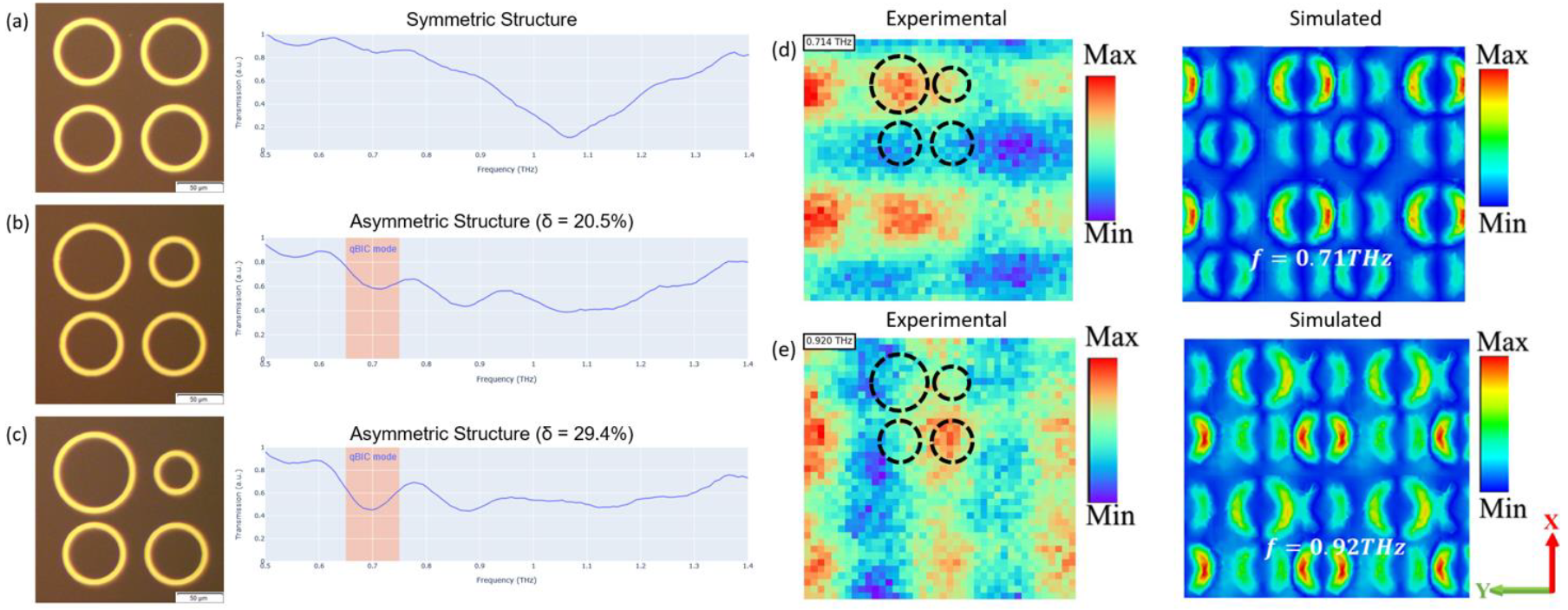| PREVIOUS PRESENTATION | BACK TO PROGRAM OVERVIEW | NEXT PRESENTATION |
Far-field and Near-field investigation of Quasi-BIC based THz Metasurface
Bhairov Kumar Bhowmik1, K. M. Rohith1, Samuel John2, Shriganesh Prabhu2 and Gagan Kumar1
1Department of Physics, Indian Institute of Technology Guwahati
2Tata Institute of Fundamental Research, Mumbai, India
Recent advancements in the field of optics and photonics have significantly propelled towards high quality (high Q-factor) electromagnetic resonances. These investigations are inspired by the versatility of such resonances in not only fundamental studies such as nonlinear optics and strong light matter interactions, but also in practical applications like sensing, optical switching, etc. [1-6]. Managing losses is critical in metamaterials to achieve a narrow spectral response. Losses can be categorized into non-radiative and radiative losses, and minimizing them involves careful material selection and design optimization. In the THz frequency range, Drude metals exhibit high conductivity, resulting in lower non-radiative losses compared to optical communication or visible bands [7]. Consequently, minimizing losses in metallic metamaterials in the THz frequency range primarily revolves around tackling radiative losses. Recently, the phenomenon of Bound States in the Continuum (BICs) has gained significant attention for high radiative Q-factor resonators. These BICs possess the theoretical notion of zero radiative loss, which prevents them from interacting with their surroundings and cannot be excited from far-fields. To access these modes from far-field, radiation channels must be opened by introducing parametric asymmetry. The resulting sharp resonances accessed in this manner are referred to as Quasi-BICs [8,9]. These quasi-BICs can be extensively tuned to obtain the desired Q-factor by varying the introduced asymmetry.

Figure 1: Microscope image and experimental transmission spectrum of metasurfaces with (a) symmetric structure, (b) asymmetric structure (with asymmetry parameter δ = 20.5%) and (c) asymmetric structure (with asymmetry parameter δ = 29.4%). Experimental and simulated abs(E\sub>z) field distributions of metasurface (with asymmetry parameter δ = 29.4%) at frequencies (d) 0.71THz and (e) 0.92THz.
We designed a ring-shaped metamolecule system (fig. 1 (b, c)) in which we selectively break the symmetry of only half the resonators in the metamolecule through radial perturbation. In contrast to traditional methods that uniformly disturb symmetry across all resonators to induce a quasi-BIC mode [10,11], selective symmetry breaking reduces radiative losses and boosts the Q-factor of quasi-BIC modes. We studied the far-field response of the metasurface using a conventional THz-TDS system. The emergence of quasi-BIC modes by symmetry breaking was investigated by measuring the far-field transmission spectrum of metasurfaces with symmetric and asymmetric structures (fig. 1 (a, b, c)). We also experimentally investigated the near-field distribution of the electric field of the metasurface (fig. 1 (d, e)) using a nearfield THz time domain microscopy setup. With the corroboration of simulation and the experimental results we validated the presence of the high-Q BIC mode using this symmetry breaking technique. This work has the potential to pave the way for the creation of innovative THz devices with promising applications in sensing, filtering, and non-linearity.
References
[1] S. Jafar-Zanjani, J. Cheng, V. Liberman, J. B. Chou, and H. Mosallaei, “Large enhancement of third-order nonlinear effects with a resonant all-dielectric metasurface,”, AIP Advances 6, 11 (2016)
[2] Kodigala, Ashok, et al. “Lasing action from photonic bound states in continuum,” Nature 541.7636, 196-199 (2017)
[3] F. Lu, H. Ou, and Y.-S. Lin, “Reconfigurable terahertz switch using flexible L-shaped metamaterial,” Opt. Lett. 45(23), 6482 (2020), DOI: 10.1364/OL.402949.
[4] N. H. Shen et al., “Optically implemented broadband blueshift switch in the terahertz regime,” Phys. Rev. Lett. 106(3), 037403 (2011)
[5] Koshelev, K. L., et al. “Strong coupling between excitons in transition metal dichalcogenides and optical bound states in the continuum,” Physical Review B 98(16), 161113 (2018)
[6] Romano, Silvia, et al. “Label-free sensing of ultralow-weight molecules with all-dielectric metasurfaces supporting bound states in the continuum,” Photonics Research 6(7), 726-733 (2018)
[7] L. Cong, M. Manjappa, N. Xu, I. Al-Naib, W. Zhang, and R. Singh, “Fano Resonances in Terahertz Metasurfaces: A Figure of Merit Optimization,” Adv Opt Mater. 3(11) 1537–1543 (2015), doi: 10.1002/adom.201500207.
[8] Kumar, Brijesh, et al. “A universal and stable metasurface for photonic quasi bound state in continuum coupled with two dimensional semiconductors,” Journal of Physics D: Applied Physics 56(42), 425105 (2023)
[9] X. Zhang, W. Shi, J. Gu, L. Cong, X. Chen, K. Wang, Q. Xu, J. Han, and W. Zhang, “Terahertz metasurface with multiple BICs/QBICs based on a split ring resonator,” Optics Express, 30(16), 29088–29098 (2022)
[10] T. Zhang, X. Zhang, Y. Shen, Y. Xu, L. Luo, J. Gu, S. Yang, J. Xu, and X. Deng, “Experiment on terahertz metasurfaces of metal split ring resonators with bound state in the continuum,” APL Materials, 11(5), 051102 (2023)
[11] L. Cong, S. Tan, R. Yahiaoui, F. Yan, W. Zhang, and R. Singh, “Experimental demonstration of ultrasensitive sensing with terahertz metamaterial absorbers: A comparison with the metasurfaces,” Appl. Phys. Lett. 106(3), 031111 (2015), doi: 10.1063/1.4906109.
